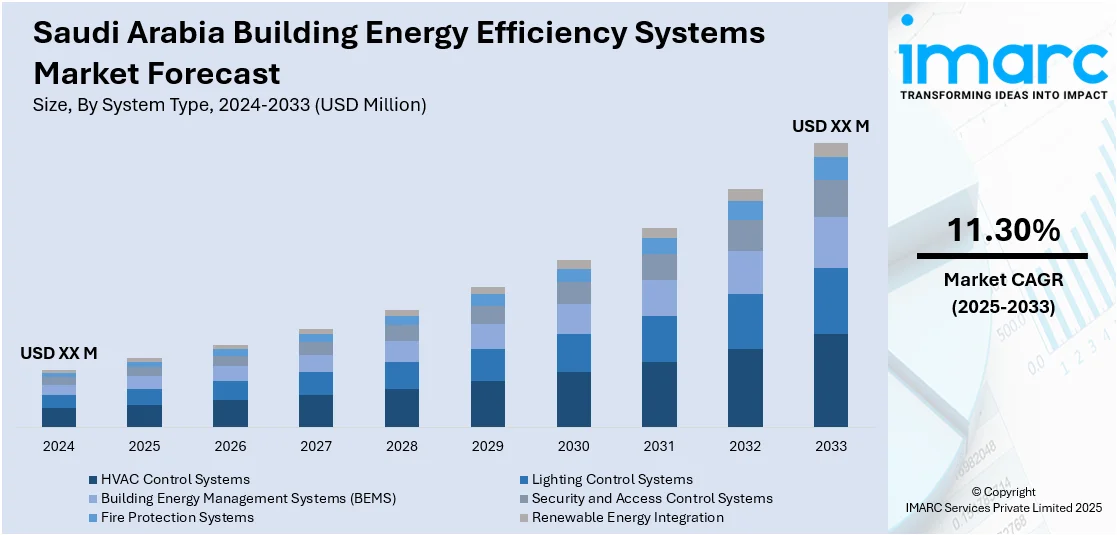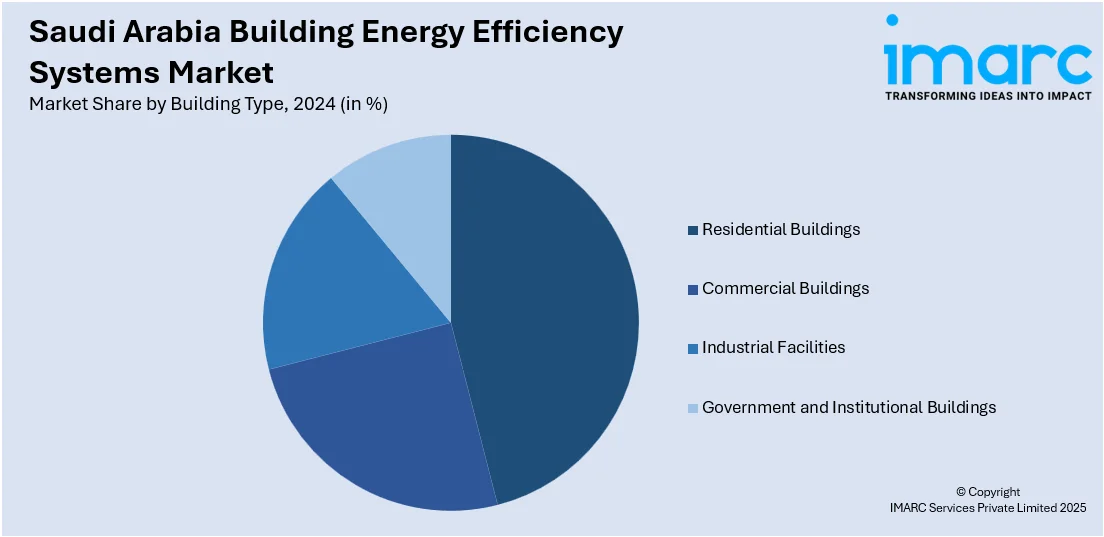
Saudi Arabia Building Energy Efficiency Systems Market Size, Share, Trends and Forecast by System Type, Building Type, Deployment Mode, Technology Type, and Region, 2025-2033
Saudi Arabia Building Energy Efficiency Systems Market Overview:
The Saudi Arabia building energy efficiency systems market size is anticipated to exhibit a growth rate (CAGR) of 11.30% during 2025-2033. The market is dominated by government policies such as Vision 2030, which emphasizes energy conservation and sustainable development. Economic reforms such as the abolishment of energy subsidies compel firms to incorporate energy-saving measures. Enhanced technological progress in building automation and control systems allows energy-saving technologies to be implemented. Smart and sustainable building demand is further increasing the Saudi Arabia building energy efficiency systems market share.
|
Report Attribute
|
Key Statistics
|
|---|---|
|
Base Year
|
2024
|
|
Forecast Years
|
2025-2033
|
|
Historical Years
|
2019-2024
|
| Market Growth Rate 2025-2033 | 11.30% |
Saudi Arabia Building Energy Efficiency Systems Market Trends:
Government Incentives and Policy Support
The government of Saudi Arabia is a key driver for energy efficiency in the building industry. The government, under Vision 2030, has put in place numerous initiatives to encourage energy savings and sustainability. For example, the Saudi Building Code (SBC) requires energy-efficient building designs and construction techniques for new buildings. The government also provides subsidies and tax credits for projects that use energy-saving technologies. These policies not only promote the use of energy-efficient systems but also provide a conducive environment for investments in building energy efficiency. Consequently, the Saudi Arabia building energy efficiency systems market growth is greatly impacted by these encouraging governmental policies.

Rising Demand for Sustainable and Smart Buildings
There is a growing trend towards the development of sustainable and smart buildings in Saudi Arabia, driven by both environmental considerations and economic benefits. For instance, as per industry reports, Saudi Arabia is advancing energy efficiency to meet its 2060 net-zero target. Buildings, responsible for nearly 47% of global CO₂ emissions, are a key focus. Businesses and consumers are increasingly focusing on energy-efficient structures that provide lower operation expenses and greater comfort. This is reflected in the growing instances of green building certifications and the use of energy-efficient systems in new buildings. Further, the need for smart buildings with sophisticated energy management systems is growing, as they provide enhanced operating efficiency and lower energy demand. This is complemented by the policies and initiatives of the government towards supporting sustainable development. Therefore, Saudi Arabia building energy efficiency systems market share keeps growing, a sign of the country's advancement towards energy saving and sustainability.
Saudi Arabia Building Energy Efficiency Systems Market Segmentation:
IMARC Group provides an analysis of the key trends in each segment of the market, along with forecast at the country/regional levels for 2025-2033. Our report has categorized the market based on system type, building type, deployment mode, and technology type.
System Type Insights:
- HVAC Control Systems
- Lighting Control Systems
- Building Energy Management Systems (BEMS)
- Security and Access Control Systems
- Fire Protection Systems
- Renewable Energy Integration
The report has provided a detailed breakup and analysis of the market based on the system type. This includes HVAC control systems, lighting control systems, building energy management systems (BEMS), security and access control systems, fire protection systems, and renewable energy integration.
Building Type Insights:

- Residential Buildings
- Commercial Buildings
- Industrial Facilities
- Government and Institutional Buildings
A detailed breakup and analysis of the market based on the building type have also been provided in the report. This includes residential buildings, commercial buildings, industrial facilities, and government and institutional buildings.
Deployment Mode Insights:
- On-Premises
- Cloud-Based
The report has provided a detailed breakup and analysis of the market based on the deployment mode. This includes on-premises and cloud-based.
Technology Type Insights:
- Wired Systems
- Wireless Systems
A detailed breakup and analysis of the market based on the technology type have also been provided in the report. This includes wired systems and wireless systems.
Regional Insights:
- Northern and Central Region
- Western Region
- Eastern Region
- Southern Region
The report has also provided a comprehensive analysis of all the major regional markets, which include Northern and Central Region, Western Region, Eastern Region, and Southern Region.
Competitive Landscape:
The market research report has also provided a comprehensive analysis of the competitive landscape. Competitive analysis such as market structure, key player positioning, top winning strategies, competitive dashboard, and company evaluation quadrant has been covered in the report. Also, detailed profiles of all major companies have been provided.
Saudi Arabia Building Energy Efficiency Systems Market News:
- In April 2025, United Cement Industrial Company signed a solar energy project development agreement with Tarshid to implement a clean energy system at its factory in Al-Lith, Makkah. Spanning 200,000 square meters, the initiative supports green cement production and aligns with Saudi Vision 2030 by promoting sustainability and reducing carbon emissions.
- In February 2025, Tarshid and King Abdulaziz Specialist Hospital launched a major energy efficiency retrofitting project in Al-Jouf, Saudi Arabia. Covering 10 buildings, it features advanced upgrades like energy-efficient chillers, LED lighting, and smart controls to reduce electricity use. The project targets a 22% reduction in energy consumption and aligns with national sustainability goals.
Saudi Arabia Building Energy Efficiency Systems Market Report Coverage:
| Report Features | Details |
|---|---|
| Base Year of the Analysis | 2024 |
| Historical Period | 2019-2024 |
| Forecast Period | 2025-2033 |
| Units | Million USD |
| Scope of the Report |
Exploration of Historical Trends and Market Outlook, Industry Catalysts and Challenges, Segment-Wise Historical and Future Market Assessment:
|
| System Types Covered | HVAC Control Systems, Lighting Control Systems, Building Energy Management Systems (BEMS), Security and Access Control Systems, Fire Protection Systems, Renewable Energy Integration |
| Building Types Covered | Residential Buildings, Commercial Buildings, Industrial Facilities, Government and Institutional Buildings |
| Deployment Modes Covered | On-Premises, Cloud-Based |
| Technology Types Covered | Wired Systems, Wireless Systems |
| Regions Covered | Northern and Central Region, Western Region, Eastern Region, Southern Region |
| Customization Scope | 10% Free Customization |
| Post-Sale Analyst Support | 10-12 Weeks |
| Delivery Format | PDF and Excel through Email (We can also provide the editable version of the report in PPT/Word format on special request) |
Key Questions Answered in This Report:
- How has the Saudi Arabia building energy efficiency systems market performed so far and how will it perform in the coming years?
- What is the breakup of the Saudi Arabia building energy efficiency systems market on the basis of system type?
- What is the breakup of the Saudi Arabia building energy efficiency systems market on the basis of building type?
- What is the breakup of the Saudi Arabia building energy efficiency systems market on the basis of deployment mode?
- What is the breakup of the Saudi Arabia building energy efficiency systems market on the basis of technology type?
- What is the breakup of the Saudi Arabia building energy efficiency systems market on the basis of region?
- What are the various stages in the value chain of the Saudi Arabia Building energy efficiency systems market?
- What are the key driving factors and challenges in the Saudi Arabia building energy efficiency systems market?
- What is the structure of the Saudi Arabia building energy efficiency systems market and who are the key players?
- What is the degree of competition in the Saudi Arabia building energy efficiency systems market?
Key Benefits for Stakeholders:
- IMARC’s industry report offers a comprehensive quantitative analysis of various market segments, historical and current market trends, market forecasts, and dynamics of the Saudi Arabia building energy efficiency systems market from 2019-2033.
- The research report provides the latest information on the market drivers, challenges, and opportunities in the Saudi Arabia building energy efficiency systems market.
- Porter's five forces analysis assist stakeholders in assessing the impact of new entrants, competitive rivalry, supplier power, buyer power, and the threat of substitution. It helps stakeholders to analyze the level of competition within the Saudi Arabia building energy efficiency systems industry and its attractiveness.
- Competitive landscape allows stakeholders to understand their competitive environment and provides an insight into the current positions of key players in the market.
Need more help?
- Speak to our experienced analysts for insights on the current market scenarios.
- Include additional segments and countries to customize the report as per your requirement.
- Gain an unparalleled competitive advantage in your domain by understanding how to utilize the report and positively impacting your operations and revenue.
- For further assistance, please connect with our analysts.
 Request Customization
Request Customization
 Speak to an Analyst
Speak to an Analyst
 Request Brochure
Request Brochure
 Inquire Before Buying
Inquire Before Buying




.webp)




.webp)












